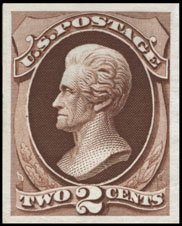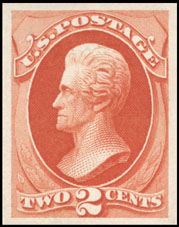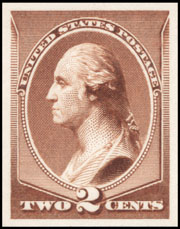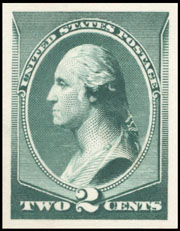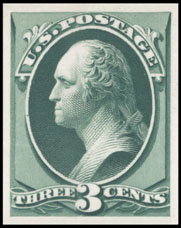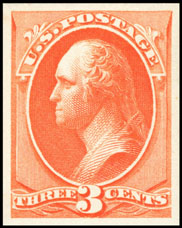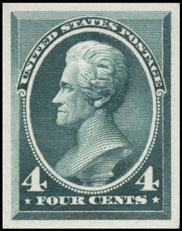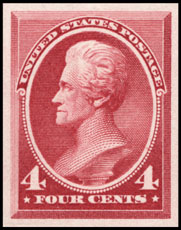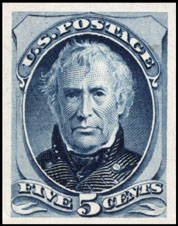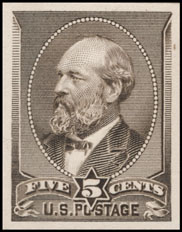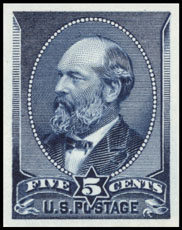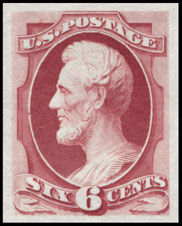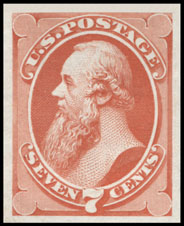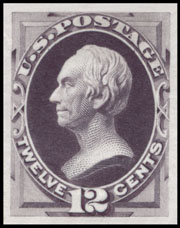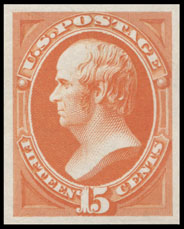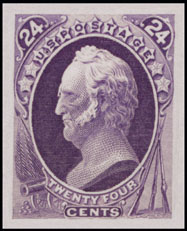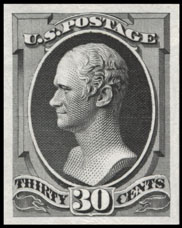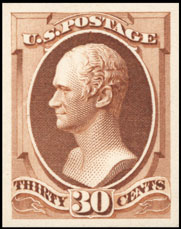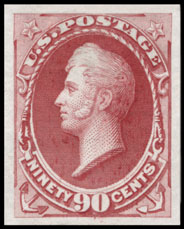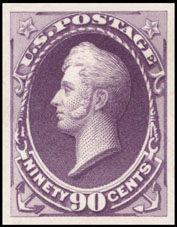
Designs of the Issues of 1870-1888
The Large Bank Notes
Perf. 12 - Unwatermarked - Uniform Design Size: 20 x 25 mm
Sheets of 200 cut into two panes of 100 stamps
All the listed National grills, except the 15¢ and 90¢ are known with end roller grills
More information
Secret Marks and IDEasy ID Large Banknotes ID Paper Types
Click on underlined Catalog Numbers below to see more details.
1¢ Franklin
of 1870-1881
Designer: Butler Packard Vignette: Joseph I. Pease
Frame: Anthony Cunningham Lettering: A. W. Cunningham
| Year | Number | EDU | No. Issued* | Printer | Grill | Colors/Varieties | Mark* | Paper | Purpose | |
| 1870 | 134 | 4/9/1870 | ~23 million | National | H;I | pale to dark ultramarine; double transfer; split/multiple grill varieties; Plate#s: --- | no | hard/white |
|
|
| 1870 | 145 | 5/7/1870 | ~120 million | National | no | pale to dark ultramarine; gray blue; double transfer; worn plate; Plate Nos. 16, 17, 50-53 | no | hard/white | ||
| 1873 | 156 | 8/22/1873 | ~448 million | Continental | no | pale to dark ultramarine; gray blue; blue; double transfer; ribbed paper; silk fibers; cogwheel punch; about thirty Pl#s are known | yes | hard/white | ||
| --- | 156a | --- | Continental | no | double paper | yes | hard/white | |||
| --- | 156e | --- | Continental | yes | with grill | yes | hard/white | |||
| --- | 156f | --- | Continental | no | imperforate pair | yes | hard/white | |||
| 1879 | 182 | 1/3/1879 | ~592 million | American | no | dark ultramarine; blue; gray blue double transfer; printed on both Continental Pl#301 and American: Pl#s 319-320, 327-328, 336-337, 344, 353-354, 355-356 |
yes | soft porous | ||
| 1881 | 206 | 10/11/1881 | ~2.2 billion | American | no | dull, gray to slate blue; ultramarine double transfer; 8-hole circle punch about 34 plate numbers known |
yes | soft porous | ||
| 1875 | 167 | n/a | 388 total for #167 & #192 | Continental | no | ultramarine | yes hard/very white | Special Printing without gum |
||
1¢ Franklin
of 1887
Designer: Thomas Morris Vignette: Alfred Jones
Frame: George H. Seymour Lettering: George H. Seymour
| Year | Number | EDU | No. Issued | Printer | Grill | Colors/Varieties | Mark | Paper | Purpose | |
| 1887 | 212 | 7/15/1887 | ~1.58 billion | American | no | ultramarine; bright ultramarine double transfer note that the proof of this stamp is of a much richer color than the issued stamp Plate Nos. R 573-577; S 578-582; T 583-587; FF 644-648; GG 649-653; JJ 664-668; PP 694-698; UU 719-723 (all plates were on the steam press) |
no | soft porous |
|
2¢ Jackson
of 1870-1873
Designer: Butler Packard Vignette: Lewis Delnoce
Frame: Douglas S. Ronaldson Lettering: D. S. Ronaldson
| Year | Number | EDU | No. Issued | Printer | Grill | Colors/Varieties | Mark | Paper | Purpose | |
| 1870 | 135 | 7/14/1870 | ~ 40 million | National | yes | pale to dark red brown; split/multiple grill; Plate#: only #45 reported |
no | hard/white |
|
|
| --- | 135a | --- | National | yes | bisect - diagonal half on cover | no | hard/white | |||
| --- | 135b | --- | National | yes | bisect - vertical half on cover | no | hard/white | |||
| 1870 | 146 | 5/7/1870 | ~212 million | National | no | pale to dark red brown; orange brown Plate Nos. 12-15, 28, 30, 34, 35, 45, 46, 47 |
no | hard/white | ||
| --- | 146a | --- | National | no | bisect - diagonal half on cover | no | hard/white | |||
| --- | 146b | --- | National | no | bisect - vertical half on cover | no | hard/white | |||
| --- | 146c | --- | National | no | bisect - horizontal half on cover | no | hard/white | |||
| --- | 146d | --- | National | no | double impression | no | hard/white | |||
| 1873 | 157 | 7/12/1873 | ~141 million | Continental | no | brown, dark brown to dark red brown; sometimes with secret mark; double transfer; ribbed paper; cracked plate; ~ 15 Pl#s known | often | hard/white | ||
| --- | 157a | --- | Continental | no | double paper | --- | hard/white | |||
| --- | 157c | --- | Continental | yes | with grill | --- | hard/white | |||
| --- | 157d | --- | Continental | no | double impression | --- | hard/white | |||
| --- | 157e | --- | Continental | no | bisect - vertical half on cover | --- | hard/white | |||
| 1875 | 168 | n/a | 416 total for #168 & #193 | Continental | no | dark brown | yes hard/very white | Special Printing without gum |
||
2¢ Vermilion Jackson
of 1875-1878
Designer: Butler Packard Vignette: Lewis Delnoce
Frame: Douglas S. Ronaldson Lettering: D. S. Ronaldson
| Year | Number | EDU | No. Issued | Printer | Grill | Colors/Varieties | Mark | Paper | Purpose |
| 1875 | 178 | 7/15/1875 | ~112 million | Continental | no | vermilion/ double transfer; ribbed paper silk fibers; about 16 Pl#s known |
yes | yellowish wove |
see also: 2¢ Bank Note Identifier |
| --- | 178a | --- | Continental | no | double paper | yes | |||
| --- | 178b | --- | Continental | no | bisect on cover | yes | |||
| --- | 178c | --- | Continental | yes | with grill | yes | |||
| 1878 | 183 | 8/19/1878 | ~547 million | American | no | vermilion to orange vermilion/double transfer Continental Plate #s 241, 242, 296, 297 and American Plate #s 338, 339, 391-394, 412, 413 |
yes | soft porous | |
| --- | 183a | --- | American | no | double impression | yes | soft porous | ||
| --- | 183b | --- | American | no | bisect on cover | yes | soft porous | ||
| 1875 | 180 | n/a | 917 total for #180 & #203 | Continental | no | carmine vermilion | yes | hard/white | Special Printing without gum |
| 1880 | 203 | n/a | American | no | scarlet vermilion | yes | soft porous |
2¢ Washington
of 1883
Designer: Thomas F. Morris Vignette: Alfred Jones
Frame: Douglas S. Ronaldson Lettering: D. S. Ronaldson
| Year | Number | EDU | No. Issued | Printer | Grill | Colors/Varieties | Mark | Paper | Purpose | |
| 1883 | 210 | 10/1/1883 First Day | ~4.49 billion | American | no | red brown, dark red brown, orange brown; double transfer; approximately 110 plate numbers are known | no | soft porous |
|
|
| 1885 | 211B | n/a | ~1000 | American | no | pale red brown;
marginal inscription "STEAMER - AMERICAN BANK NOTE COMPANY." |
no | soft porous | Special Printing without gum |
|
| --- | 211Bc | --- | American | no | horizontal pair imperforate between | no | soft porous |
2¢ Washington
of 1887
Designer: Thomas F. Morris Vignette: Alfred Jones
Frame: Douglas S. Ronaldson Lettering: D. S. Ronaldson
| Year | Number | EDU | No. Issued | Printer | Grill | Colors/Varieties | Mark | Paper | Purpose |
| 1887 | 213 | 9/20/1887 off-cover dated cancel 9/21/1887 on cover |
~4.54 billion | American | no | green, bright green, dark green double transfer over 130 plate numbers are known, all printed on the steam press |
no | soft porous | (see
two-cent stamp of 1883, above) |
| --- | 213b | --- | American | no | printed on both sides | no | soft porous |
3¢ Washington
of 1870-1881
Designer: Butler Packard Vignette: Joseph P. Ourdan
Frame: Douglas S. Ronaldson Lettering: D. S. Ronaldson
| Year | Number | EDU | No. Issued* | Printer | Grill | Colors/Varieties | Mark | Paper | Purpose | |
| 1870 | 136 | 3/24/1870 | ~172 million | National | H;I | pale to deep green; yellow green; double transfer; split/multiple/end-roller grills cracked plate; Plate #s: 1, 5, 8, 11, 31, 44, 55 |
no | hard/white |
|
|
| --- | 136a | --- | National | yes | setenant pair - one w/o grill | no | hard/white | |||
| --- | 136b | --- | National | no | printed on both sides | no | hard/white | |||
| 1870 | 147 | 3/1/1870 | ~1.03 billion | National | no | pale to deep green; yellow green double transfer; cracked plate Plate Nos. 1-11, 25, 29, 31, 32, 36-44, 54, 55 |
no | hard/white | ||
| --- | 147a | --- | National | no | printed on both sides | no | hard/white | |||
| --- | 147b | --- | National | no | double impression | no | hard/white | |||
| 1873 | 158 | 7/17/1873 | ~2.66 billion | Continental | no | green; bluish to yellow to olive to dark green ribbed paper; silk fibers; cracked plate dbl transfer; cogwheel punch; >100 Pl#s |
yes | hard/white | ||
| --- | 158a | --- | National | no | double paper | yes | hard/white | |||
| --- | 158e | --- | National | yes | with grill | yes | hard/white | |||
| --- | 158h | --- | National | no | horizontal pair imperforate vertically | yes | hard/white | |||
| --- | 158i | --- | National | no | horizontal pair imperforate between | yes | hard/white | |||
| --- | 158j | --- | National | no | double impression | yes | hard/white | |||
| --- | 158k | --- | National | no | printed on both sides | yes | hard/white | |||
| 1879 | 184 | 7/2/1878 predate |
~1.27 billion | American | no | light to dark
green/double transfer Continental & American plates (~ 34 plates) |
yes | soft porous | ||
| --- | 184b | --- | American | no | double impression | yes | soft porous | |||
| 1881 | 207 | 8/7/1881 | ~1.48 billion | American | no | blue green, green, yellow green double transfer; cracked plate 8-hole circle punch; ~34 Pl#'s |
yes | soft porous | ||
| --- | 207c | --- | American | no | double impression | yes | soft porous | |||
| 1875 | 169 | n/a | 267 total for #169 & #194 | Continental | no | blue green; known on cover | yes hard/ very white | Special Printing without gum |
||
| 1880 | 194 | n/a | American | no | blue green | yes | soft porous | |||
3¢ Vermilion Washington
of 1887
Designer: Butler Packard Vignette: Joseph P. Ourdan
Frame: George H. Seymour Lettering: D. S. Ronaldson
| Year | Number | EDU | No. Issued | Printer | Grill | Colors/Varieties | Mark | Paper | Purpose | |
| 1887 | 214 | 9/23/1887 | 20,167,800 | American | no | vermilion; Plate no. 421 |
yes | soft porous |
|
4¢ Jackson
of 1883
Designer: Thomas F. Morris Vignette: Alfred Jones
Frame: Douglas S. Ronaldson Lettering: D. S. Ronaldson
| Year | Number | EDU | No. Issued | Printer | Grill | Colors/Varieties | Mark | Paper | Purpose |
| 1883 | 211 | 10/1/1883 First Day | 76,164,425 | American | no | blue green, deep blue green;
double transfer; cracked plate; Plate Nos. 456, 457 and L 542-546 (STEAM PRESS) |
no | soft porous | The four-cent Jackson was issued to meet the demand for postage on a double weight domestic first class letter. |
| 1883 | 211D | n/a | 26 | American | no | deep blue green | no | soft porous | Special Printing without gum |
4¢ Jackson
of 1888
Designer: Thomas F. Morris Vignette: Alfred Jones
Frame: Douglas S. Ronaldson Lettering: D. S. Ronaldson
| Year | Number | EDU | No. Issued | Printer | Grill | Colors/Varieties | Mark | Paper | Purpose | |
| 1888 | 215 | 12/26/1888 | 28,105,850 | American | no | carmine, pale rose, rose carmine; Plate Nos. L 542-546 |
no | soft porous |
|
5¢ Taylor
of 1875-1879
Designer: Butler Packard (frame) Vignette: Charles Skinner
Frame: D. S. Ronaldson Lettering: D. S. Ronaldson
| Year | Number | EDU | No. Issued | Printer | Grill | Colors/Varieties | Mark | Paper | Purpose | |
| 1875 | 179 | 7/10/1875 | ~15.3 million | Continental | no | blue, greenish blue, bright to dark blue double transfer; ribbed paper silk fibers; cracked plate Plate Nos. 243, 244, 247, 248, 284, 306 |
no | yellowish wove |
|
|
| --- | 179a | --- | Continental | no | double paper | no | ||||
| --- | 179c | --- | Continental | no | with grill/end roller grill | no | ||||
| 1879 | 185 | 1/16/1879 | ~42 million | American | no | light blue to dark blue;
double transfer; Printed on both Continental Plate # 306 and American Plate #s 325, 326, 379, 380 |
no | soft porous | ||
| 1875 | 181 | n/a | 317 total for #181 & #204 | Continental | no | bright blue | no | hard/white | Special Printing without gum |
|
| 1880 | 204 | n/a | American | no | deep blue | no | soft porous |
5¢ Garfield
of 1882
Designer: Thomas F. Morris Vignette: Charles Skinner
Frame: D. S. Ronaldson Lettering: D. S. Ronaldson
| Year | Number | EDU | No. Issued | Printer | Grill | Colors/Varieties | Mark | Paper | Purpose |
| 1882 | 205 | First Day: 4/10/1882 2/18/1882 reported |
170,894,020 | American | no | yellow brown, brown,
gray brown; Plate Nos. 399, 400, 488, 489, K 537-541 |
no | soft porous | Five cents paid the UPU rate for many foreign destinations. |
| 1882 | 205C | 2/17/1882 reported |
---- | American | no | gray brown | no | soft porous | Special Printing without gum |
5¢ Garfield
of 1888
Designer: Thomas F. Morris Vignette: Charles Skinner
Frame: D. S. Ronaldson Lettering: D. S. Ronaldson
| Year | Number | EDU | No. Issued | Printer | Grill | Colors/Varieties | Mark | Paper | Purpose |
| 1888 | 216 | 3/15/1888 | 58,898,680 | American | no | indigo, deep blue; Plate Nos. K 537-541 |
no | soft porous | Five cents paid the UPU rate for many foreign destinations. |
6¢ Lincoln
of 1870-1882
Designer: Butler Packard Vignette: Joseph P. Ourdan
Frame: Douglas S. Ronaldson Lettering: D. S. Ronaldson
| Year | Number | EDU | No. Issued | Printer | Grill | Colors/Varieties | Mark | Paper | Purpose | |
| 1870 | 137 | 4/11/1870 | ~1.56 million | National | H;I | carmine; pale carmine; carmine rose; split/multiple and end roller grill varieties | no | hard/white |
|
|
| --- | 137a | --- | National | H;I | setenant pair - one w/o grill | no | hard/white | |||
| 1870 | 148 | 3/28/1870 | ~25.8 million | National | no | carmine; violet to brown to dark carmine; rose Plate Nos. 26, 27 |
no | hard/white | ||
| --- | 148a | --- | National | no | bisect - vertical half on cover | no | hard/white | |||
| --- | 148b | --- | National | no | double impression | no | hard/white | |||
| --- | 148c | --- | National | no | double paper | no | hard/white | |||
| 1873 | 159 | 6/8/1873 | ~38.3 million | Continental | no | dull pink, brown rose/ribbed paper; silk fibers Pl#s: 18, 21, 304, 305 |
yes | hard/white | ||
| --- | 159a | --- | Continental | no | bisect - diagonal half on cover | yes | hard/white | |||
| --- | 159b | --- | Continental | yes | with grill | yes | hard/white | |||
| --- | 159c | --- | Continental | no | double paper | yes | hard/white | |||
| 1879 | 186 | 4/18/1879 | ~20.7 million | American | no | pink, brownish rose Continental plate Nos. 304, 305 |
yes | soft porous | ||
| 1882 | 208 | 6/1/1882 First Day | 11,689,400 | American | no | rose, dull rose; deep brownish red double transfer; Plate nos. 426, 427 |
yes | soft porous | ||
| --- | 208a | --- | American | no | pale to deep brown red | yes | soft porous | |||
| 1875 | 170 | --- | 185 total for #170 & #195 | Continental | no | dull rose | yes hard/ very white | Special Printing without gum |
||
7¢ Stanton
of 1871-1873
Designer: Butler Packard Vignette: Joseph P. Ourdan
Frame: Douglas S. Ronaldson Lettering: D. S. Ronaldson
| Year | Number | EDU | No. Issued | Printer | Grill | Colors/Varieties | Mark | Paper | Purpose | |
| 1871 | 138 | 2/12/1871 | ~800,000 | National | yes | vermilion to deep vermilion split/multiple and end roller grill varieties Plate #s: none reported |
no | hard/white |
|
|
| 1871 | 149 | 5/11/1871 | ~2.07 million | National | no | vermilion to deep vermilion cracked plate; Plate No. 33 |
no | hard/white | ||
| 1873 | 160 | 9/10/1873 | ~2.5 million | Continental | no | vermilion; orange vermilion/double transfer ribbed paper; silk fibers, Pl#: 22 |
yes | hard/white | ||
| --- | 160a | --- | Continental | no | with grill | yes | hard/white | |||
| --- | 160b | --- | Continental | no | double paper | yes | hard/white | |||
| 1875 | 171 | n/a | 473 total for #171 & #196 | Continental | no | reddish vermilion | yes | hard/ very white | Special Printing without gum |
|
| 1880 | 196 | n/a | American | no | scarlet vermilion | yes | soft porous |
10¢ Jefferson
of 1870-1882
Designer: Butler Packard Vignette: Luigi Delnoce
Frame: Douglas S. Ronaldson Lettering: D. S. Ronaldson
| Year | Number | EDU | No. Issued | Printer | Grill | Colors/Varieties | Mark | Paper | Purpose | |
| 1870 | 139 | 5/6/1870 | ~479,000 | National | yes | brown, yellow brown; dark brown split, double and end roller grill varieties |
no | hard/white |
|
|
| 1870 | 150 | 5/14/1870 on piece |
~10.2 million | National | no | brown, yellow brown; dark brown Dbl transfer; Pl#'s 18, 19 (48, 49 proofs only) |
no | hard/white | ||
| 1873 | 161 | 8/2/1873 | ~21.5 million | Continental | no | brown, dark brown double transfer; ribbed paper; silk fibers Plate Nos. 23, 25, 302, 303 |
yes | hard/white | ||
| --- | 161a | --- | Continental | no | double paper | yes | hard/white | |||
| --- | 161c | --- | Continental | yes | with grill | yes | hard/white | |||
| --- | 161d | --- | Continental | no | horizontal pair imperf between | yes | hard/white | |||
| 1879 | 187 | 9/5/1879 | ~11 million | American | no | yellow brown, brown double transfer; setenant pair with Sc 188; printed on American Plate Nos. 377, 378 |
no | soft porous | ||
| --- | 187a | --- | American | no | double paper | no | soft porous | |||
| 1879 | 188 | 10/5/1878 | ~22 million | American | no | yellow brown to black brown; double transfer; setenant/Scott 187; cracked plate printed on Continental Pl #s 302, 303 |
yes | soft porous | ||
| 1882 | 209 | 5/4/1882 | ~151 million | American | no | many shades of brown Plate Nos. 403, 403A, 404A, 481, M 547-551 |
no | soft porous | ||
| --- | 209b | --- | American | no | black brown | no | soft porous | |||
| --- | 209c | --- | American | no | double impression | no | soft porous | |||
| 1875 | 172 | n/a | 180 total for #172 & #197 | Continental | no | pale brown | yes hard/ very white | Special Printing without gum |
||
| 1880 | 197 | n/a | American | no | deep brown | sometimes soft | ||||
12¢ Clay
of 1870-1873
Designer: Butler Packard Vignette: Luigi Delnoce
Frame: Douglas S. Ronaldson Lettering: D. S. Ronaldson
| Year | Number | EDU | No. Issued | Printer | Grill | Colors/Varieties | Mark | Paper | Purpose | |
| 1870 | 140 | 6/17/1870 | ~66,000 | National | yes | dull violet split grill; end roller grill |
no | hard/white |
|
|
| 1870 | 151 | 7/9/1870 | ~3.26 million | National | no | dull violet; violet; dark violet Plate No. 24 |
no | hard/white | ||
| 1873 | 162 | 1/3/1874 | ~2.92 million | Continental | no | blackish violet; ribbed paper 12¢ Secret marks - Plate No. 137 |
yes | hard/white | ||
| --- | 162a | --- | Continental | yes | with grill | yes | hard/white | |||
| 1875 | 173 | n/a | 282 total for #173 & #198 | Continental | no | dark violet | yes | hard/ very white |
Special Printing without gum |
|
| 1880 | 198 | n/a | American | no | blackish purple | yes | soft porous |
15¢ Webster
of 1870-1879
Designer: Butler Packard Vignette: Luigi Delnoce
Frame: Douglas S. Ronaldson Lettering: D. S. Ronaldson
| Year | Number | EDU | No. Issued | Printer | Grill | Colors/Varieties | Mark | Paper | Purpose | |
| 1870 | 141 | 6/2/1870 | ~558,000 | National | yes | orange; deep orange; bright orange split/multiple grill varieties; Plate #: 20 |
no | hard/white |
|
|
| 1870 | 152 | 6/24/1870 | ~5.03 million | National | no | pale to light orange Pl.#: 20 |
no | hard/white | ||
| --- | 152a | --- | National | no | double impression | no | hard/white | |||
| 1873 | 163 | 7/22/1873 | ~3.05 million | Continental | no | orange to deep reddish orange ribbed paper; silk fibers; Plate No. 31 |
often | hard/white | ||
| --- | 163a | --- | Continental | yes | with grill | often | hard/white | |||
| --- | 163c | --- | Continental | no | double paper | often | hard/white | |||
| 1879 | 189 | 1/20/1879 | ~14.4 million | American | no | red orange,
yellow orange to orange double transfer; Continental plate No. 31 |
some- times |
soft porous | ||
| 1875 | 174 | n/a | 169 total for #174 & #199 | Continental | no | bright orange | hard/ very white | Special Printing without gum |
||
| 1880 | 199 | n/a | American | no | orange | soft porous | ||||
24¢ Scott
of 1870-1873
Designer: Butler Packard Vignette: Joseph P. Ourdan
Frame: Douglas S. Ronaldson Lettering: D. S. Ronaldson
| Year | Number | EDU | No. Issued | Printer | Grill | Colors/Varieties | Mark | Paper | Purpose | |
| 1870 | 142 | 7/11/1872 | ~8,500 | National | yes | purple; split/multiple grill grill with points up; end roller grill Plate #s: none reported |
no | hard/white |
|
|
| 1870 | 153 | 11/18/1870 | ~1.14 million | National | no | purple; bright purple/ Pl.# 21 | no | hard/white | ||
| --- | 153a | --- | National | no | double paper | no | hard/white | |||
| 1873 | 164 | n/a | possibly 365,000 | Continental | no | purple (on vertically ribbed paper); only one copy is certified |
no | hard/white | ||
| 1875 | 175 | n/a | 286 total for #175 & #200 | Continental | no | dull purple | no | hard/ very white |
Special Printing without gum |
|
| 1880 | 200 | n/a | American | no | dark violet | no | soft porous |
30¢ Hamilton
of 1870-1882
Designer: Butler Packard Vignette: Joseph P. Ourdan
Frame: Douglas S. Ronaldson Lettering: D. S. Ronaldson
| Year | Number | EDU | No. Issued | Printer | Grill | Colors/Varieties | Mark | Paper | Purpose | |
| 1870 | 143 | 8/18/1870 | ~77,000 | National | yes | black to full black; double grill; end roller grill | no | hard/white |
|
|
| 1870 | 154 | 7/13/1870 | ~786,000 | National | no | black; full black/Plate No. 22 | no | hard/white | ||
| 1873 | 165 | 10/14/1874 | ~782,500 | Continental | no | gray black, greenish black/double transfer ribbed paper; silk fibers; Plate No. 22 |
no | hard/white | ||
| --- | 165a | --- | Continental | no | double paper | no | hard/white | |||
| --- | 165c | --- | Continental | yes | with grill | no | hard/white | |||
| 1879 | 190 | 4/5/1881 | ~4.1 million | American | no | greenish black to full black printed on American plate No. 405 |
some times |
soft porous | ||
| 1875 | 176 | n/a | 179 total for #176 & #201 | Continental | no | greenish black | no | hard/ very white |
Special Printing without gum |
|
| 1880 | 201 | n/a | American | no | greenish black | no | soft porous |
30¢ Hamilton
of 1888
Designer: Butler Packard Vignette: Joseph P. Ourdan
Frame: Douglas S. Ronaldson Lettering: D. S. Ronaldson
| Year | Number | EDU | No. Issued | Printer | Grill | Colors/Varieties | Mark | Paper | Purpose |
| 1888 | 217 | 6/26/1888 off cover 9/7/1888 on cover |
710,720 | American | no | orange brown, deep orange brown; Plate No. 405 |
yes | soft porous | (see 30¢ above) |
90¢ Perry
of 1870-1882
Designer: Butler Packard Vignette: Luigi Delnoce
Frame: Douglas S. Ronaldson Lettering: D. S. Ronaldson
| Year | Number | EDU | No. Issued | Printer | Grill | Colors/Varieties | Mark | Paper | Purpose | |
| 1870 | 144 | 4/12/1870 reported |
~53,300 | National | yes | carmine to rich carmine double grill; split grill |
no | hard/white |
|
|
| 1870 | 155 | 9/1/1872 4/29/1871 reported |
~160,000 | National | no | carmine; rich (dark) carmine Plate No. 23 |
no | hard/white | ||
| 1873 | 166 | 6/25/1875 | ~197,000 | Continental | no | rose carmine, pale rose carmine National plate No. 23 |
no | hard/white | ||
| 1879 | 191 | 5/27/1882 off cover 6/24/1882 on cover |
~280,670 | American | no | carmine, rose, carmine rose National plate No. 23 |
no | soft porous | ||
| --- | 191a | American | no | double paper | no | soft porous | ||||
| 1875 | 177 | n/a | 170 total for #177 & #202 | Continental | no | violet carmine | no | hard/ very white |
Special Printing without gum |
|
| 1880 | 202 | n/a | American | no | dull carmine | no | soft porous |
90¢ Perry
of 1888
Designer: Butler Packard Vignette: Lewis Delnoce
Frame: Douglas S. Ronaldson Lettering: D. S. Ronaldson
| Year | Number | EDU | No. Issued | Printer | Grill | Colors/Varieties | Mark | Paper | Purpose |
| 1888 | 218 | 9/?/1888 off cover dated cancel 10/29/1888 on cover |
103,130 | American | no | purple, bright purple; Plate No. 23 |
no | soft porous | (see 90¢ above) |
The EDU information is based on the best information available.
The printing companies have been listed in shorthand to fit in the space provided. The companies are as follows:
"National" = National Bank Note Company
"Continental" = Continental Bank Note Company
"American" = American Bank Note Company
Although the "secret mark" could be considered a design feature, it is not included in the list of designers in the banner at the top of each stamp. Credit for these marks should be given to Charles Skinner.
The secret marks used to separate the National and Continental stamps can be very problematic. On the lower denominations identification is fairly straightforward, although many collectors still separate the stamps based on color, particularly the two-cent stamp. This is also the method that most use to separate the higher denominations, so pay attention to the colors listed.
"Secret" marks are found on the die proofs of the twenty-four and ninety-cent Continental stamps, which had the rays in the stars strengthened, and the thirty-cent Continental proof stamp, which had a line of shading added to the bottom of the shield. These "secret marks" will be found only on the die proofs.
The so-called secret mark on the fifteen-cent stamp has caused much controversy. It is generally accepted that the apparent strengthening of the "V" in the upper left triangle is found on many, but not all, Continental and American printings. For now, it is probably best to simply sort your fifteen-cent large Bank Notes on hard white paper by color. Any on soft porous paper are of course the American stamp, Scott 189.
Double Paper: The double paper was described by John Luff as being composed of two parts: a "very thin paper, backed by a thicker and firmer one". In theory, the "impressions were to be made on the thin paper which, it was expected, would be destroyed by any attempt to remove a cancellation." (Burns, U.S. Specialist March 1999). This was not always the case, however, since impressions were at least sometimes made on the thicker paper. The collector should bear in mind that the Bank Note double papers are composed of one thick paper and one very thin paper.
The thirty-cent stamp is also interesting. In 1989 Jack Rosenthal published an article in Linn's that showed a clear alteration in the triangular protrusions in the "S" of "CENTS" on some of the American printings, that is Scott 190 and Scott 217. Not all American printings show this alteration, or "secret mark" if you choose, however if the alteration is present the stamp must be an American printing. The American printings were on a soft porous paper making them easily identifiable in any case, but it may help in weeding out Continentals printed on the soft, "transitional" paper. The Micarelli guide lists the Continentals on "soft white" paper, but it is not listed here to prevent confusion.
*Quantity issued:
Estimates are based on available information, primarily from Brookman, "The United States Postage Stamps of the 19th Century- Volume I", and "Linn's U.S. Stamp Facts 19th Century", published by Linn's Stamp News. These numbers are simply estimates based on the best information available and are subject to revision. Please report any updates or corrections via email.
Special Printings:
The 1875 Special Printings were issued to showcase a complete set of the U.S. issues for the first World's Fair officially held in the U.S., at the Centennial International Exposition of 1876 in Philadelphia and also to provide stamps for collectors and others to satisfy numerous requests. Since the stamps of this issue were still in circulation and available at Post Offices, they were not "reissues" per se and are listed simply as "special printings". They are very difficult to distinguish from the regularly issued stamps, other than the very white paper.
Bibliography and suggested additional reading:
Basic Information:
The Postage Stamps of the 19th Century, Volume II, by Lester Brookman (1966)
The Postage Stamps of the 19th Century, Volume III, by Lester Brookman (1967)
The 2011 Scott Specialized Catalogue of United States Stamps & Covers, Scott Publishing Co. 2010
Linn's U.S. Stamp Facts 19th Century, by Elliot A. Landau, editor (1999)
The United States Two Cent Red Brown of 1883-1887, by Edward L. Willard (1970 - 2 vol.)
The U.S. 3c Green 1870-1887, by H. L. Wiley (Severn-Wylie-Jewett booklet #9 - copyright 1915)
U.S. 1887 3 Cent Vermilion, by Dr. H. A. Davis (1922)
The Seven Cent Vermilion U.S. 1871-1873 Issue, by J. W. Sampson(Severn-Wylie-Jewett booklet #42 undated)
Comments on the 10c stamps of 1870-1882, with profile of Jefferson, by Elliott Perry (Collector's Club Philatelist 1949)
Notes on the 10 Cents Jefferson 1870-1879, by Cyril F. dos Passos(22nd American Philatelic Congress)
The United States 15c Stamp of 1870-1890, by William R. Weiss Jr.(1995)
Notable Auction Sales:
U.S. Bank Note Issues, Featuring the Mercedes Collection - Robert A. Siegel Auction Galleries #922 October 19, 2006
Design dimensions:
The Postage Stamps of the United States, John Luff (1902 and 1937)
The design dimensions are from Luff unless otherwise noted.
Colors:
The Encyclopedia of the Colors of United States Postage Stamps - Volume 2 Issues of 1869-1893, by Roy H. White (1981)
The Micarelli Identification Guide to U.S. Stamps: Regular Issues 1847-1934 by Charles N. Micarelli
Additional Resources
Year In Stamps - 1870 Collectors Club USPCS Chronicle Siegel Auction GalleriesBrookman PDF download


